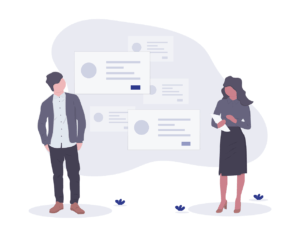Mastering the equipment used by personnel in the field: an essential responsibility for an IT department. Our tools allow users to be included in support, IS, the detection of good practices and anomalies, as well as in the creation of knowledge bases.

Requirements
The fundamental of CIOs remains robustness. While today it is tempting to leave users with applications that are easy to configure in order to relieve development teams, IT Departments do not forget their primary responsibility: to ensure the production of trades without raising the risks of the company.
However, mobile applications on tablets and smartphones confront IT departments with many challenges that ease of configuration should not hide:
- users isolated from the company must have an “all-terrain” tool at their disposal
- users must be able to be effectively supported
- the company must be reassured of the quality of the work performed away from its facilities
- the company must be able to justify the quality of the tools given to its users
- the SaaS dimension facilitates deployment and thus amplifies potential problems
However, connected nomad applications face a triple volatility of their specifications, opening the door to many requests for evolution:
- Functionally, applications must evolve with each change in regulations or technical practices.
- Behaviorally, applications must evolve with each organizational change.
- Technically, applications must evolve with each change in the technical configuration, especially when using the IoT, industrial networks or communicating sensors.

Answer
Our rich experience of mobile environments and IT constraints has led us to create a platform specifically designed for complex projects, far from the simple “forms management”. This platform includes of course the configuration of forms, but also — and especially — workflow, inputs/outputs, connectivity, Machine Learning, IoT integration…
In a nutshell, one of our main innovations is to provide an adaptive application rather than a separate “studio” for parameterization of our execution engines.
We typically propose three levels of adaptation:
- exceptions and user adjustment, which does not require computer knowledge but only business knowledge;
- simple changes, which can be made/supervised by managers or power users;
- complex modifications, for which the intervention of computer specialists will be required.
These three levels complement each other to provide a solution that can support a very broad spectrum of applications, from simple questionnaires to real high-level applications.
Whatever the level of adjustment, our solution allows a deployment on “SandBox” or in production in one click, including work flow, distribution, configuration management, non-regression tests, log management, connectivity to IT and directories of the company, etc..

Benefits
Based on our experience, we offer a tool whose true power is revealed throughout its entire life cycle.
In the initial development phases, it allows users to work in a “short loop” to quickly achieve a powerful application in its collection of data in the field and their exploitation.
During its operation, it also provides many opportunities to present multi-actor dashboards (staff, managers, IT operator, support center, process manager, etc.).
Less time to program = more time for the job!
Our ambition is to enable IT Departments not only to give businesses the possibility of creating applications, but above all that these do not become “silos” without control or evolution.
Geek's Corner
Our architecture is based on micro-services to optimize operational deployment and security. A Kafka message system enables high performance technical articulations and a high degree of control.